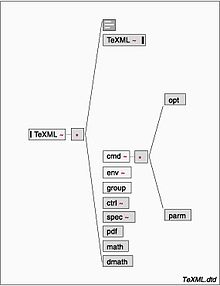TeXML
| (TeXML)
|
|
|---|---|

|
|
| Basic data
|
|
| developer | Oleg A. Parashenko |
| Current version | December 2010 |
| operating system | lots |
| category | Pleading |
| License | WITH |
| http://www.getfo.org/ | |
TeXML [tɛχːml] is - as a process - a TeX- based alternative to XSL-FO .
TeXML was developed as an open source project with the aim of displaying XML data automatically and in a sophisticated layout as PDF.
With the help of an additional structure definition, TeXML bridges the syntax differences between TeX and XML.
Technically, the markup elements of TeX are represented in XML syntax.
development
TeXML is a further development of the specification originally created by IBM, whereby a distinction must be made between structure and transformation .
- structure
- The XML definition of the TeXML structure has been concluded in 1999 (TeXML.dtd).
- It is the markup link between TeX and XML.
- transformation
- The transformation processes have been working in a stable manner since the end of 2010, so that the technology can be used productively.
- The originally attempted approach of a Java application was abandoned by IBM and not pursued any further.
application
TeXML is used to create technical documentation from XML data.
After the transformation TeXML → TeX, the collection of TeX macros defined by LaTeX is available.
With the help of the TeX macros it is possible to define any configurable layout for the publication of XML data .
particularities
- TeXML allows the automatic publication of XML data using a typesetting program designed for manual typesetting .
- In contrast to publication with the XSL-FO technology, the layout of the XML data to be published can be subtly influenced with exception rules in the intermediate code.
- Exception rules can be learned from the publication process, so the layout is improved with each generation run.
- High speed of the publication process, especially for large documents up to 100 times the speed compared to XSL-FO based processes.
TeXML structure
The document type definition of the TeXML structure consists of the XML elements:
- Root element: TeXML
- Encoding commands: cmd
- Encoding environments: env
- Encoding groups: group
- Encoding math groups: math and dmath
- Encoding control symbols: ctrl
- Encoding special symbols: spec
- PDF literals: pdf
Structure of a TeXML document
An example of an XML document that has already been transformed into the TeXML structure:
<TeXML>
<TeXML escape="0">
\documentclass[a4paper]{article}
\usepackage[latin1]{inputenc}
\usepackage[T1]{fontenc}
</TeXML>
<env name="document">
Die Fehlinterpretation von Sonderzeichen als Steuerzeichen nennt man "Escaping", also: $, ^, >
</env>
</TeXML>
TeXML process
The TeXML process transforms the XML data in the TeXML intermediate format to TeX:
\documentclass[a4paper]{article}
\usepackage[latin1]{inputenc}
\usepackage[T1]{fontenc}
\begin{document}
Die Fehlinterpretation von Sonderzeichen als Steuerzeichen nennt man "Escaping", also: \textdollar{}, \^{}, \textgreater{}
\end{document}
Support of the processes
The work on the acquisition level (XML) and the publication level (TeX) are supported by various tools , for example:
- Acquisition level: XML editors
- - Eclipse (IDE) , open source
- - other free XML editors
- Publication level: Synchronization between the code and the output PDF using pdfSync:
literature
- Frank Mittelbach The LaTeX Companion - Tools and techniques for computer typesetting
- Michel Goossens The XeTeX Companion (PDF; 3.1 MB) - TeX meets OpenType and Unicode
Web links
- SGML / XML and (La) TeX - solution approaches to represent XML as TeX
- TeXML: an XML syntax for TeX - TeXML project (download)
- How to embed pdfsync into pdftex - synchronization between code and PDF
- TeXML: Typesetting XML with TEX (PDF; 182 kB) - Original conception of the TeXML project
- TeXML: A three-part solution that provides a path from XML into the TeX formatting language - Brief description of the project by IBM Research (archive)
